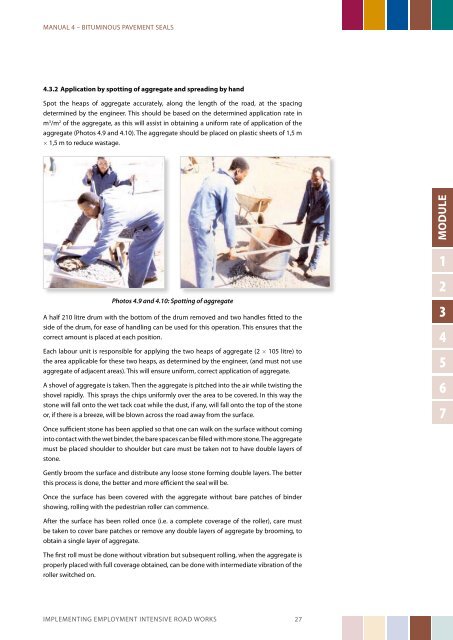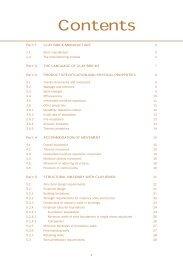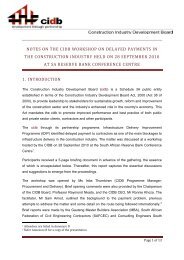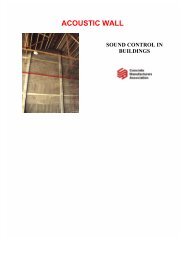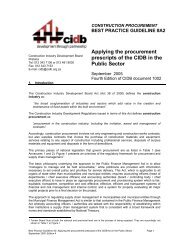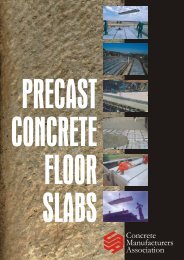MANUAL 4 - Construction Industry Development Board
MANUAL 4 - Construction Industry Development Board
MANUAL 4 - Construction Industry Development Board
Create successful ePaper yourself
Turn your PDF publications into a flip-book with our unique Google optimized e-Paper software.
<strong>MANUAL</strong> 4 – BITUMINOUS PAVEMENT SEALS<br />
4.3.2 Application by spotting of aggregate and spreading by hand<br />
Spot the heaps of aggregate accurately, along the length of the road, at the spacing<br />
determined by the engineer. This should be based on the determined application rate in<br />
m 3 /m 2 of the aggregate, as this will assist in obtaining a uniform rate of application of the<br />
aggregate (Photos 4.9 and 4.10). The aggregate should be placed on plastic sheets of 1,5 m<br />
3 1,5 m to reduce wastage.<br />
Photos 4.9 and 4.10: Spotting of aggregate<br />
A half 210 litre drum with the bottom of the drum removed and two handles fitted to the<br />
side of the drum, for ease of handling can be used for this operation. This ensures that the<br />
correct amount is placed at each position.<br />
Each labour unit is responsible for applying the two heaps of aggregate (2 3 105 litre) to<br />
the area applicable for these two heaps, as determined by the engineer, (and must not use<br />
aggregate of adjacent areas). This will ensure uniform, correct application of aggregate.<br />
A shovel of aggregate is taken. Then the aggregate is pitched into the air while twisting the<br />
shovel rapidly. This sprays the chips uniformly over the area to be covered. In this way the<br />
stone will fall onto the wet tack coat while the dust, if any, will fall onto the top of the stone<br />
or, if there is a breeze, will be blown across the road away from the surface.<br />
Once sufficient stone has been applied so that one can walk on the surface without coming<br />
into contact with the wet binder, the bare spaces can be filled with more stone. The aggregate<br />
must be placed shoulder to shoulder but care must be taken not to have double layers of<br />
stone.<br />
Gently broom the surface and distribute any loose stone forming double layers. The better<br />
this process is done, the better and more efficient the seal will be.<br />
Once the surface has been covered with the aggregate without bare patches of binder<br />
showing, rolling with the pedestrian roller can commence.<br />
After the surface has been rolled once (i.e. a complete coverage of the roller), care must<br />
be taken to cover bare patches or remove any double layers of aggregate by brooming, to<br />
obtain a single layer of aggregate.<br />
The first roll must be done without vibration but subsequent rolling, when the aggregate is<br />
properly placed with full coverage obtained, can be done with intermediate vibration of the<br />
roller switched on.<br />
IMPLEMENTING EMPLOYMENT INTENSIVE ROAD WORKS 27<br />
MODULE<br />
1<br />
2<br />
3<br />
4<br />
5<br />
6<br />
7


